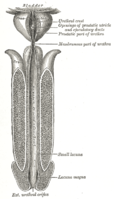
Photo from wikipedia
Since the first case of COVID-19 infection in the Northern Italy on the 14th of February, there have been significant changes not only in the routine hospital activities, but also… Click to show full abstract
Since the first case of COVID-19 infection in the Northern Italy on the 14th of February, there have been significant changes not only in the routine hospital activities, but also in healthcare workers’ life, who have been continuously exposed to high risk of Cov2 infections and stressful conditions. When the emergency started, little was known about how fast the virus was spreading and inadequate contact precautions were used during medical procedures, resulting in a high healthcare workers (HCW) infection rate and hundreds of deaths. Then, we have gradually understood that clinical manifestations of the COVID-19 infections are often absent or elusive, as also some procedures are considered at high risk for exposure, especially gastrointestinal and upperairway endoscopy. HCW who perform or assist during these procedures are exposed to aerosolization risks due to droplets inhalation or conjunctival contact. Aim of this letter is to remark on the approach carried out by our Pediatric Surgery Division located in Padua (Veneto), which is one of the most affected area. From 15 March to 30 April we hospitalized 103 pediatric patients. To reduce the number of patients’ hospital accesses and guarantee social distancing, all the activities in our Division were rearranged according to clinical risk stratification; this was particularly valid for the endoscopic procedures, considering the increased risk of Cov2 transmission related to this practice. For this reason, during the time period mentioned above, only emergency and nondeferrable urgent procedures were guaranteed, and a total of 30 pediatric patients underwent the following endoscopic procedures: management of severe airway obstruction (five cases), aerodigestive foreign body removal (eight cases), soft tissue abscess drainage (three cases), hematemesis (four cases), and bleeding from digestive tract (ten cases). For all these patients, a specific COVID-19 pathway was planned to safeguard the entire endoscopy staff (endoscopists, anesthetists and nurses). First, patients and caregivers were triaged at the entrance of the Emergency Department to detect typical infection-related symptoms, such as fever, cough, flu-like symptoms, or gastrointestinal symptoms, or recent close contact with a confirmed or probable case of COVID-19 infection. Then, all patients and caregivers underwent oro and nasopharyngeal swab at the same time. In the case of emergencies whereby the swab results were not available, e.g., severe airway obstruction, patients were always considered potentially infected and the entire endoscopy team had to take specific protective measures and follow the instructions for a correct dressing and undressing procedure. Then, all of them had to wear adequate personal protective equipment (PPE), including FFP2 masks (FFP3 for the anesthetist and their nurses), full-face shield, fluid resistance gown, two pairs of gloves and shoes covering. At the end of the procedure, the operative room was always completely sterilized, the endoscope carefully reprocessed, and the patient isolated in a specific COVID-19 ward until the swab results were available. On the other hand, if the patient did not require immediate assistance, the procedure was postponed till the COVID-19 swab result was available. This practice significantly reduced the waste of advanced protective equipment in case of negative patients, considering the shortage and the high costs of medical supply during the emergency. In fact, in these patients, surgical procedures were performed with standard PPE and precautions. In our experience, a total of seven patients required emergency procedures, thus the protocol described before was * Miriam Duci [email protected]
Journal Title: Pediatric Surgery International
Year Published: 2020
Link to full text (if available)
Share on Social Media: Sign Up to like & get
recommendations!